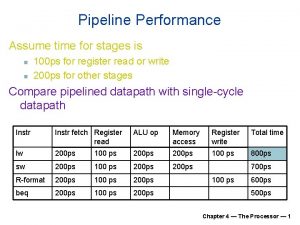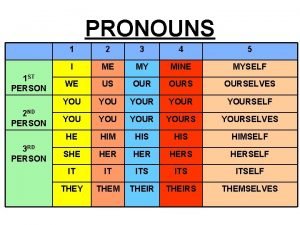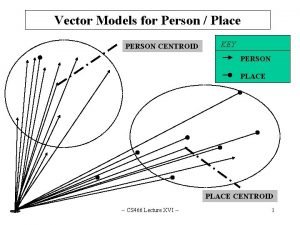Power Energy Energy Power x time Assume person















- Slides: 15

Power & Energy • Energy = Power x time • Assume person can output 50 watts of useful power for a 10 hour day. • 1 watt = 1 joule/ 1 second • 4186 joules = 1 food calorie • ? joules in 1 day of work? • E = Pt = (50 watts)(10 h)(3600 s/h) = 1, 800, 000 joules 1

How much food? • 1, 800, 000 joules /(4186 joule/Cal) = 430 Calories. • Actual consumption? ~ 5 x 430 = 2150 Cal. • Food Calorie = Cal = kcal = 1000 cal • Actual calorie unit is just “cal” 2

How fast? • • • P = 50 watts Block m = 100 kg mg = 1000 N Assume f = mg/2 = 500 N P = E/t = Work/t = Fd/t = F(d/t) = Fv 50 watts = (500 N)(v) V = 50 watts/500 N = 0. 1 m/s 3

blocks • Density = 2 g/cm 3 = 2000 kg/m 3. • Volume = width x height x depth = (1. 5)(1. 0)(2/3) = 1. 0 m 3. • Mass = density x volume = (2000 kg/m 3)(1. 0 m 3) = 2000 kg • W = mass x gravity = (2000 kg)(10 N/kg) = 20, 000 N 4

Force to pull block • Estimate that it takes half* weight to pull the block: 10, 000 N • Each person pulls ~ 200 N for the 5 km. • #people x 200 N = 10, 000 N • #people = 50 • Power = force x velocity • 50 watts = 200 N x v: v = 0. 25 m/s • * i. e. frictional coefficient = 0. 5 5

Time to pull block • • Distance = velocity x time 5000 m = 0. 25 m/s x time Time = 20, 000 seconds = 20, 000 s/3, 600 s/h = 5. 5 hours • Time to return for another one!: • Time = 5000 m/1 m/s = 5000 s = 1. 5 hour 6

Volume of pyramid • Volume = 1/3 base x height • = 1/3 x (230 m)2 x 150 m = 2, 645, 000 m 3. • - cavities, estimate 2, 000 blocks!! 7

Raising a block • Now we need a force equal to all the weight • This doubles the force needed. • Work = force x distance • Example: raise 1 block 100 meters high. • Work = weight x 100 m = 20, 000 N x 100 m = 2, 000 joules 8

Ramp used to raise block. • Ramp is a simple machine. The principle is the same as for leverage (torque): • f. D = Fd • small force f applied for large distance D equals a large force F over a short distance d. • If double # people raise block (100) they could move it straight up. 9

2 a-1 • 100 people moving it up seems too high. • Lets say 20 people move it up ramp, each pulling with 200 N force. • f. D = Fh • f = 20 x 200 N, D = distance along ramp • F = 20, 000 N, h = 150 meters height • (20 x 200)(D) = (20, 000)(150) • D = 750 m 10

Force to go up ramp: • About equal to (weight of block)/5 + some frictional force which is probably about equal to (weight of block)/4. • Previous slide neglect friction. 11

2 a-2 • Ramp angle is about 11. 5 degrees (use calculator). 750 m 12

reminders • • • Quiz III, ch. 7 -9, April 11 (Wednesday) Pyramid Report: Due April 18. Do I need to type out questions? Yes All text should be typed. Formulas can be hand written. 13

review 1 • Calculate times: vt = distance • T 1(drag one block to pyramid): 5000 meters/(e. g. 0. 25 m/s) =20000 s =about 5. 5 h. • T 1’ (walk back): 1. 5 h • T 2(drag block to average height = 1/3 total height, i. e. 50 m) 14

review 2 • Figure total effort in Mh (man-hour) to move one block all the way to pyr. And up 50 m and walk back for another block. • E. g. 50 Mx 7. 5 h = 375 Mh for one block • 3, 000 x 375 Mh = 1. 1 x 109 Mh. • Mh/(20, 000 h) = 56, 000 people. 15
 1 person singular and plural
1 person singular and plural Point of view first second and third person
Point of view first second and third person Person person = new person()
Person person = new person() First person second person third person chart
First person second person third person chart Start time end time and elapsed time
Start time end time and elapsed time Characteristics of academic writing slideshare
Characteristics of academic writing slideshare First person vs third person writing
First person vs third person writing Person-job fit and person-organization fit
Person-job fit and person-organization fit I remember the newspaper dying like huge moths
I remember the newspaper dying like huge moths Class person string name person(string name)
Class person string name person(string name) When a person is logrolled the person is
When a person is logrolled the person is Language features of biography
Language features of biography One person's garbage is another person's treasure
One person's garbage is another person's treasure When moving a person in segments what do you move first
When moving a person in segments what do you move first What is dynamic character
What is dynamic character Person a and person b
Person a and person b



























